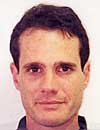Wimbledon: What Game
Does It Take to Win?
Matt Cronin
 |
Borg was winning but the experts called for serve and volley. |
In the late 1970s, it was still claimed by some that winning Wimbledon required a serve and volley style. This of course was an absurd assertion, as Bjorn Borg had already dominated the tournament for years.
Year after year, major analysts dismissed the Swede's chances of winning the tournament again because he played primarily from the backcourt. Even his fellow players had trouble understanding that a fundamental transition had occurred.
Take Brian Gottfried, for example, the American who faced the Swede in the 1980 Wimbledon semis. A true attacking player, Gottfried had won a grass court tournament at Surbiton coming into Wimbledon, scoring impressive wins over Stan Smith, Phil Dent and Wotjek Fibak.
Going into the tournament, he felt that he might be able to suffocate Borg by getting on top of the net at every possible chance. That wasn't how it happened.
In his match against Borg, Gottfried tried to force the action, but often found himself standing above the net cord with his mouth agape in a 6-2, 4-6, 6-2, 6-0
 |
Gottfried believed he could smother Borg at the net. |
"To me one of the miracles of sport was Borg winning Wimbledon five times with the way he played. The courts weren't the same quality as they are now. There were real divots in them," Gottfried told me while I was researching my forthcoming book, Epic: John McEnroe, Bjorn Borg and the Greatest Season in Tennis Ever."
"It was strange to play a guy who seemingly never got a bad bounce." "He moved so well and passed so well that you had to do something special with your first volley. He was so good under pressure, and was incredibly fit."
"You are playing someone whose second serve you can attack, but he's playing from the baseline and you are struggling to know how to play," Gottfried said.
"I think grass helped him in two respects: he could still crack a first serve when he was down, and he came into net with a little slice backhand that was effective. He didn't hit a firm volley, but the ball would just die."
Is Federer a power baseliner and is that what it takes? |
"I served and volleyed on most first serves and on my second serves, I tried to come in sometimes. I did the same on his serve, but against him it didn't seem to matter at all, as I was just getting worn out."
Today, the contention you must serve and volley to win the tournament has been nearly completely reversed, with many analysts pointing to Roger Federer's recent dominance of the tournament as evidence that the grass has measurably slowed down.
For all intents and purposes, Federer is an aggressive baseliner, and has explicitly said he no longer plays serve and volley. And then there is backcourt dominator Nadal, winning Wimbledon in 2008. Not to mention baseline grinder Lleyton Hewitt, taking the crown in 2002. Conventional wisdom has become that the world's fastest surface has given over men who prefer groundstrokes.
But is it really that simple? Between Borg and Federer there was a player named Pete Sampras, not to mention Goran Ivanisevic and Richard Krajicik. These players played serve and volley. But a major part of their success was not backing up their serves with winning volleys, but their serves themselves.
A serve and volley interlude with 7 Sampras championships. |
In fact, in the past 35 years, there have only been four men with average first serves who have won the title -- Jimmy Connors, Andre Agassi, Hewitt and Nadal. Every other titlist, including Borg and Federer, were capable of racking up large numbers of service winners and aces.
The same is true of the many serve and volleyers who ruled the tournament at various times: net lovers such as John McEnroe, Boris Becker, Stefan Edberg, Pat Cash and Michael Stich for example. All had dominating serves.
And look at some of the finalists: huge servers such as Roscoe Tanner, Kevin Curren, Mark Philippoussis, Andy Roddick, and even Ivan Lendl.
Richard Krajicik: one of the majority of champions with huge serves. |
The Return
Beyond the serve, the other key factor that is often overlooked on the grass is the return. Borg used to say that the return of serve was more important than the serve on grass, because on fast surfaces it's much easier to hold than it is to break.
In his five titles runs, he certainly proved his point. Agassi, Hewitt and Nadal are also among the best return of servers ever.
You can throw Federer into that category too. While the 16-time Grand Slam champion isn't usually hyper aggressive with his return, he may be the best at getting the ball back in play, even against guys with blowtorch serves like Roddick, whom he has beaten in three Wimbledon finals.
When asked what his strategy is against America's top player, Federer says that he tries to get the return in play and then "create something." And no one is more creative than Federer with an unmatched variety of shot, including the ability to volley well, even if he has renounced it as his principal style.
Among the best returners, the second pre-requisite on grass. |
So winning Wimbledon is no longer a matter of game style. Strength of serve and return are what is most required, regardless of how different players back them up. Still the net still can play a role. There may be fewer points decided there, but the points that are can be decisive in a given match.
Since Borg seized control of the tournament in 1976, it is certainly true that automatically rushing the net off the serve or chipping and charging at every opportunity is no longer a winning strategy. But the ability to at least close some points out at the net, whether it's on the third, fifth seventh or 20th ball has often helped determine the champion.
In 2008, a few volleys at critical times made the difference for Nadal. |
Take a peak at the stats of Nadal's 6-4, 6-4, 6-7, 6-7, 9-7 win over Federer in the 2008 final. The Swiss rushed the net 75 times, winning 42 approaches, a 56 % conversation rate. Nadal approached the net 31 times, winning 22 attempts, a 71% conversion rate. In a match that tight, where Nadal only won five more total points than Federer, it may be fair to say that those 22 points Nadal won at the net were a deciding factor.
The conclusion is that it's not longer an either/or situation at the "Big W," where one style or another is a fast track to the crown. The serve and the return are probably still most heavily weighted on grass.
But, as on hardcourts, and even the faster clay courts, being an excellent all around player is a necessity or you may as well forget about the All England Club saving you seat in Locker Room "A." Then again, who knows when the next great player will emerge and unexpectedly take some element of game style to a new dominant level.
Matt Cronin is covering his 15th Wimbledon this year, which is his 51st Grand Slam.






